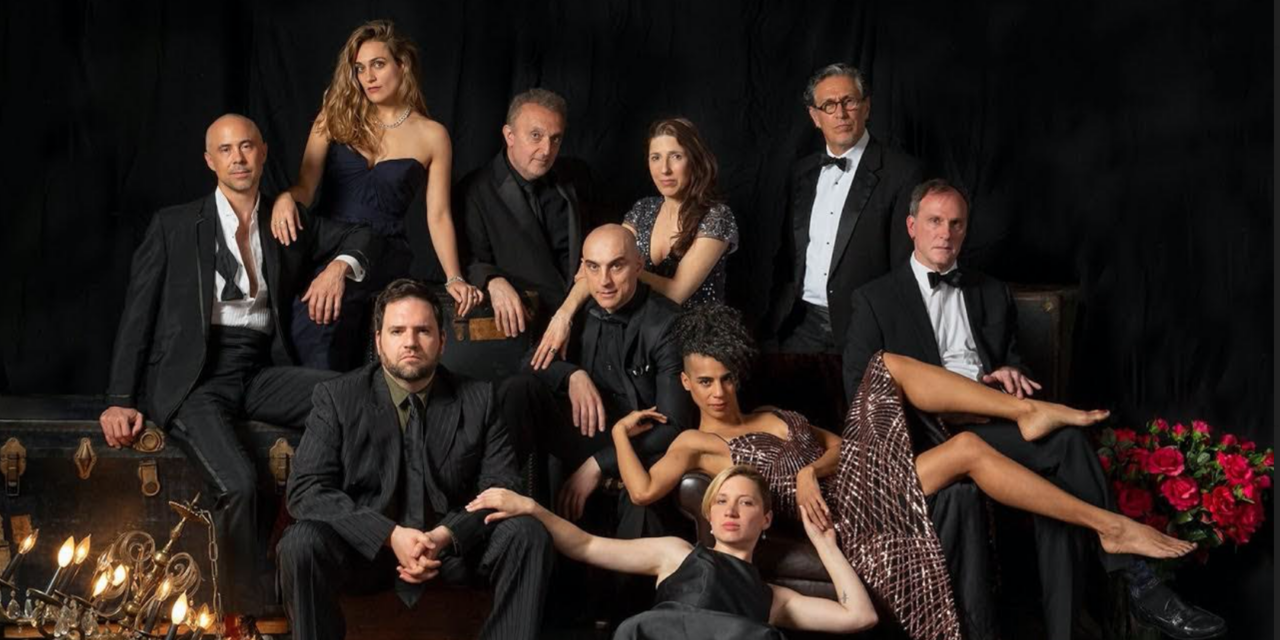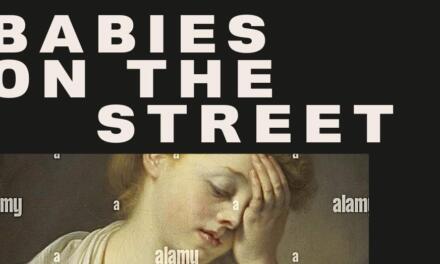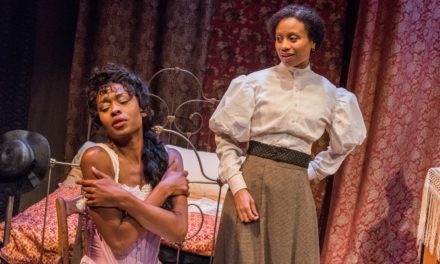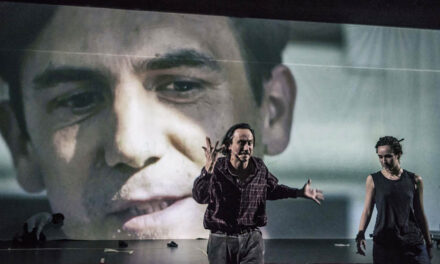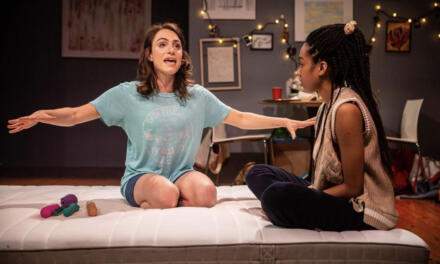Gia Forakis is the Founder and Artistic Director of GF&CO in Brooklyn, NY. Gia is also the Founder and Master Teacher of the One-Thought-One-Action (OTOA)™ performance technique. GF&CO’s newest work is a video project called This Is Not A Cure: A Ceremony for Healing, which began streaming for free on March 19, 2021.
I had the pleasure of speaking with Gia about This Is Not A Cure, GF&CO’s 10th anniversary, and the future of the company.
Victoria Isotti: I want to start by asking if you could give some background on you and your company, GF&CO.
Gia Forakis: I have been a theater artist pretty much my entire life. I got my start, if you will, in the theater when I was six or seven as a performer in a Meredith Monk performance project at the Guggenheim Museum in New York City. My mother, who is a visual artist, and was an acquaintance of Meredith, was invited to be a part of the project. At the first rehearsal, my mother decided the project wasn’t right for her, but Meredith turned to me and said, “Well, what about Gia? Does she want to be in this project?” and, without any hesitation, I said, “Yes!” That was it. It was my first exposure to theater and performing and probably says everything about my own experimental relationship with making theater.
After graduating from New York University’s Graduate Acting program, I spent my 20’s trying to be a professional actress in New York City. At that time, casting directors often found it difficult to categorize me as an actress. I was cast in a lot of downtown experimental performance projects, and dance-theater, and eventually I started creating, producing, and performing in my own work for the stage. I got a reputation for being an accessible performance artist. Later, I decided to go back to school and got my Master’s degree at Yale School of Drama in stage directing.
After Yale, my primary focus was on building my freelance career as a director. And during those first few years out of school, I began developing a performance technique I called One-Thought-One-Action, also known as OTOA. OTOA grew out of a need I had as a director to elicit a certain quality of performance from the actors in my projects, a quality that was more physical, more visual, and more detailed. As that process became more and more common in my work as a director, there grew a number of actors attracted to the principles of OTOA and who wanted an opportunity to train in the technique. So, I began renting space and teaching OTOA workshops. And from there grew GF&CO (Gia Forakis & Company), which I founded in 2011 with Managing Director, Katrina Foy, making 2021 our 10-year anniversary.
GF&CO is a Brooklyn, New York-based not-for-profit studio lab and collective of professional theater artists dedicated to the application of the OTOA performance technique. The company is built upon the premise that the arts are where we encounter our humanity, nurture our civility, and fortify our connection to one another. It took several years for our identity to really gel. Initially, we tried creating and producing theater on a conventional timeline, but that model was not only unsustainable for us, but it worked against the principles of OTOA. OTOA requires more time for investigation, experimentation, and development than is built into the conventional models and contracts that are provided by the actors’ and directors’ unions –at least the contracts that we could afford to work with. So, over time, we’ve evolved into this idea of a studio lab, which in my mind privileges process over product. It allows us to develop a new project through residencies and workshops until we feel it’s ready to bring to the stage. The pandemic put our most recent stage project on pause, but the studio-lab model is one that we developed for ourselves, and that feels aligned with our mission and the type of work we want to create.
VI: Let’s talk about GF&CO’s new project, This Is Not A Cure: A Ceremony for Healing. What inspired you to start this project?
GF: That project began during the pandemic when everything shut down. In that first month, I really began pondering what was going to happen when we came through this pandemic. Rather than wonder when our lives would resume and when theater would resume, I was asking myself what the most meaningful form of performance would be for bringing people together again, and what types of art events would be the most useful to us as a society.
I was interested in the idea of liminal time, which is that place in between where we’ve come from and where we’re going to be, or who we’ve been and who we will become. The liminal is very much associated with ceremony, which is generally built on three-four phases of ritualized performance that are usually witnessed by an audience and facilitated by experienced guides. There’s a before time, and then you start phase one–entering into the liminal. Phase two is where mystical or transformative things can happen. And in the final phase, you have transcended, and you are ceremoniously brought into a new place, a new time, a new beginning.
The early part of the pandemic was very much a liminal time, an in-between time of not knowing what or when the other side would be. And we still don’t fully know. It’s been this shared and expanded period of liminality with a rushed desire to get to the other side and to go back to who we were. But for me, the beginning of the pandemic was very spiritual. On the street, there was this sacredness, like people were just glad to be alive. I experienced an unspoken quality of respect for life, for the little things, and a sense of community and gratitude. It was liminal and transcendent, and I feel forever changed by what I have experienced so far.
When you enter the theater, you also enter a shared liminal ceremony. From the moment you enter, to the rising of the curtain, to the journey you take through the performance, and then to the bows at the end, it is a ceremony of rituals performed by experienced guides. Then the lights come up, and you return to your life, and, hopefully, in some way, you’ve been changed. Whether it’s you’re thinking or your perspective on life that has altered, you’ve shared a journey and you’ve come back. But, if the rituals worked, then you are not who you were when you first arrived. In some small incremental way, you have a different context by which to look at the world. And to me– that’s the magic of theater. That’s the experience we are consciously or unconsciously looking for when we go to sit in a room with others and share a liminal experience. It is a ceremony.
So, with all this in mind, I started thinking of how the pandemic had taken away opportunities for us to gather for the liminal experiences that live theater and live performance offer, and the idea of making creative experiences that bring together a collective of people in the creation of a ceremony for healing began to evolve. I called this idea, Creative Collective Ceremonies, or 3C’s.
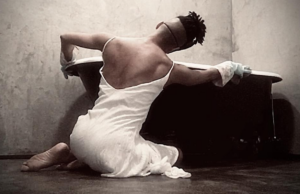
“THIS IS NOT A CURE: A CEREMONY FOR HEALING” 2021, A GF&CO 3C VIDEO : Pictured, GF&CO Member: Sharahn LaRue. An original performance-based video ceremony. Conceived & Directed & Conceived by Gia Forakis. Photo by Sharan LaRue.
VI: Can you tell me about the creation process of this piece?
GF: For the last 8 years, GF&CO has been blessed with a summer residency in Vermont in August. Last year I thought, why don’t we bring some of the members together and find a Covid- friendly way to start experimenting with this idea of Creative Collective Ceremonies (3C’s). But, due to many complications, I ended up going to Vermont solo and furthering the idea in Zoom conversations with two of our members. By the end of September, there was a real clamoring, a personal need for healing, amongst a few of the GF&CO members to move the idea of the 3C’s forward.
At that time, we were focused on creating a live public event in Summer 2021, and we started meeting every other week on Zoom. I would give a creative assignment, an exploration of ceremony, ritual, elements of loss, elements of grief, elements of healing, the elements themselves: earth, fire, water, air, and the four cardinal points: north, south, east, west. We honestly, really, truly, didn’t know where we were heading, nor how what we were doing would lead us to a live 3C performance. And we didn’t even have a budget, but there was something that had been so very rare in the “before-times” (before the pandemic) — there was a willingness and a need to work that wasn’t motivated by anything other than a yearning to come together and to create something meaningful and from the heart. And so, we just started meeting and being creative.
Over the next month, we all contributed to the process through discussion, through sharing essays, poems, photographs, and also the actors would bring in these exquisite little performance-based experiments — little ceremonies — that they’d create in their homes and share with the group on Zoom. Then, in January, Bill de Blasio, the mayor of New York, announced that March 14 was going to be a Day of Remembrance in honor of the first person who was recognized to have died of Covid in New York City. I brought that information to the group and asked if we should bump up the timeline and try to create a live 3C to perform on March 14 rather than June. But, given the state of the pandemic and the weather, we concluded it was still too soon for getting together to create or to perform anything live. As an alternative, someone in the group suggested we make a video 3C. At that point, none of us knew what that meant, but we were excited by the challenge. And once we decided we were doing a video with members living in different states, I invited two of our members who live in different countries, Hungary and Mexico, to join the project.
We continued our experimentation, and I started pulling moments and images and choreographed movement ideas from what we’d been experimenting with and began to craft, reshape, and rework them into three phases of a ceremony. That was when we were blessed with both composer and musician Katie Down, compose her original piece for us, “Awakening” and then the music of the band Undersea Poem, give us the rights to use their song “Bacohco Sunsets.”
Somewhere along the way, we realized that working towards the March 14 day of remembrance worked against our intention, which was for a ceremony of healing. Healing felt different to us from remembrance. For us, healing takes remembrance and loss into account but then carries it forwards towards something more, towards possibility of something new. And that’s when it suddenly dawned on me that March 19 was GF&CO’s 10-year anniversary of our first production. And not only was it our 10 year anniversary, but it was also the eve of the Spring Equinox– so a time of rebirth and renewal and resurrection from a long dark winter– and March 19 also happened to be my birthday. So, we chose that date to launch our video. It seemed like it was meant to be.
VI: Why did you feel it was so important for this to project be free?
GF: It connects with the deeper truth of ceremony and of our intention for healing. As the title of the video suggests, it’s not a cure. It’s a doorway for expressing intentions of healing. Having lived through last year, and still living through the turmoil and upheaval, and the challenges brought on by the pandemic, we’ve come to understand that the wide range of trauma we’ve gone through is not exclusive to Covid. What’s been revealed are the weaknesses and traumas in the social fabric and that there is a deep, deep well of pain and suffering and illness and death and social unrest and hate and fear and hurt and prejudice. For us to really fulfill our intentions and offer a performance-based ceremony of healing it seemed to me and to the group, that there should not be any kind of roadblocks. It needed to be fully accessible for whoever would benefit from or appreciate it. No sense of any restricted access, no sense that it’s only the privileged who have an extra buck or two to spend who get to experience art meant to uplift and remind us of our humanity.
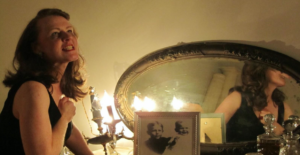
“MEDEA,” 2012 GF&CO Salon Series, Brooklyn, NY: Pictured: GF&CO Member Actor, Ninon Rogers. Directed by Gia Forakis. Photo by GF&CO
VI: Going forward, do you have any big plans for GF&CO?
GF: Good question. I have no idea! I’m not biting off time in such large chunks, particularly with this pandemic. One-Thought-One-Action is about the identification of smaller increments of thought, as smaller components of physical action. It’s my practice to apply OTOA as both my tool for creating theater, as well as my creative life practice. Most immediately, though, the next step is to find a way to develop 3Cs at live events.
VI: Is there anything else you would like to add?
GF: I would like to add that one of the things I’m most proud of with GF&CO is that, as I said, it took us a while to land on a model that really supports our vision, but that, at 10 years old, we have found a way that works for us. Our first 3C embodies all the best parts of our mission to create projects that foster and remind us of our humanity, our civility, and our connection. This is Not a Cure… is a synthesis between the idea of company, our mission, and how those two things come together and form a family of artists who speak the same language. Although we all work independently of GF&CO, we can come together in a meaningful way.
To view This Is Not A Cure: A Ceremony for Healing, please click here.
This post was written by the author in their personal capacity.The opinions expressed in this article are the author’s own and do not reflect the view of The Theatre Times, their staff or collaborators.
This post was written by Victoria Isotti.
The views expressed here belong to the author and do not necessarily reflect our views and opinions.

